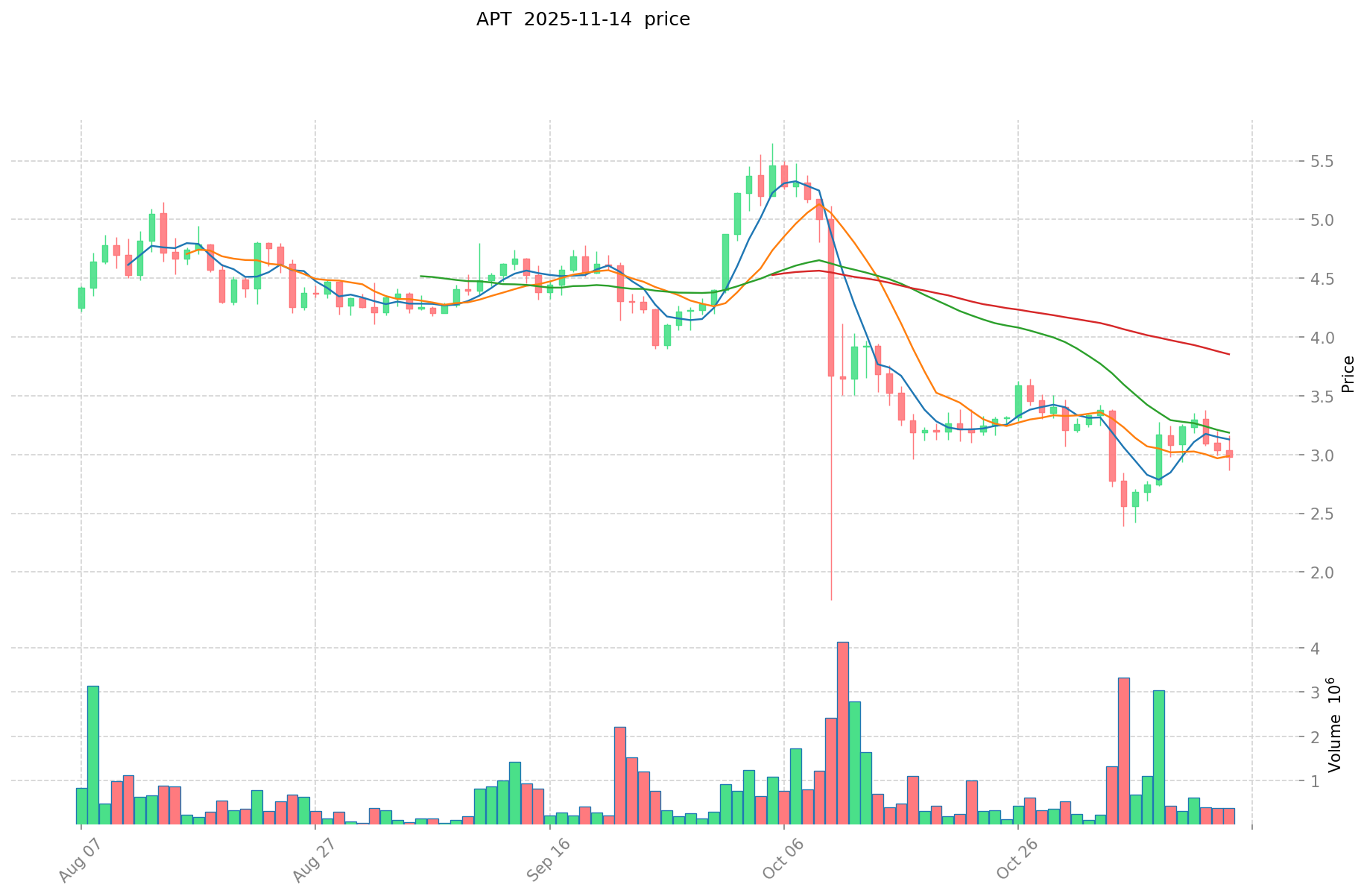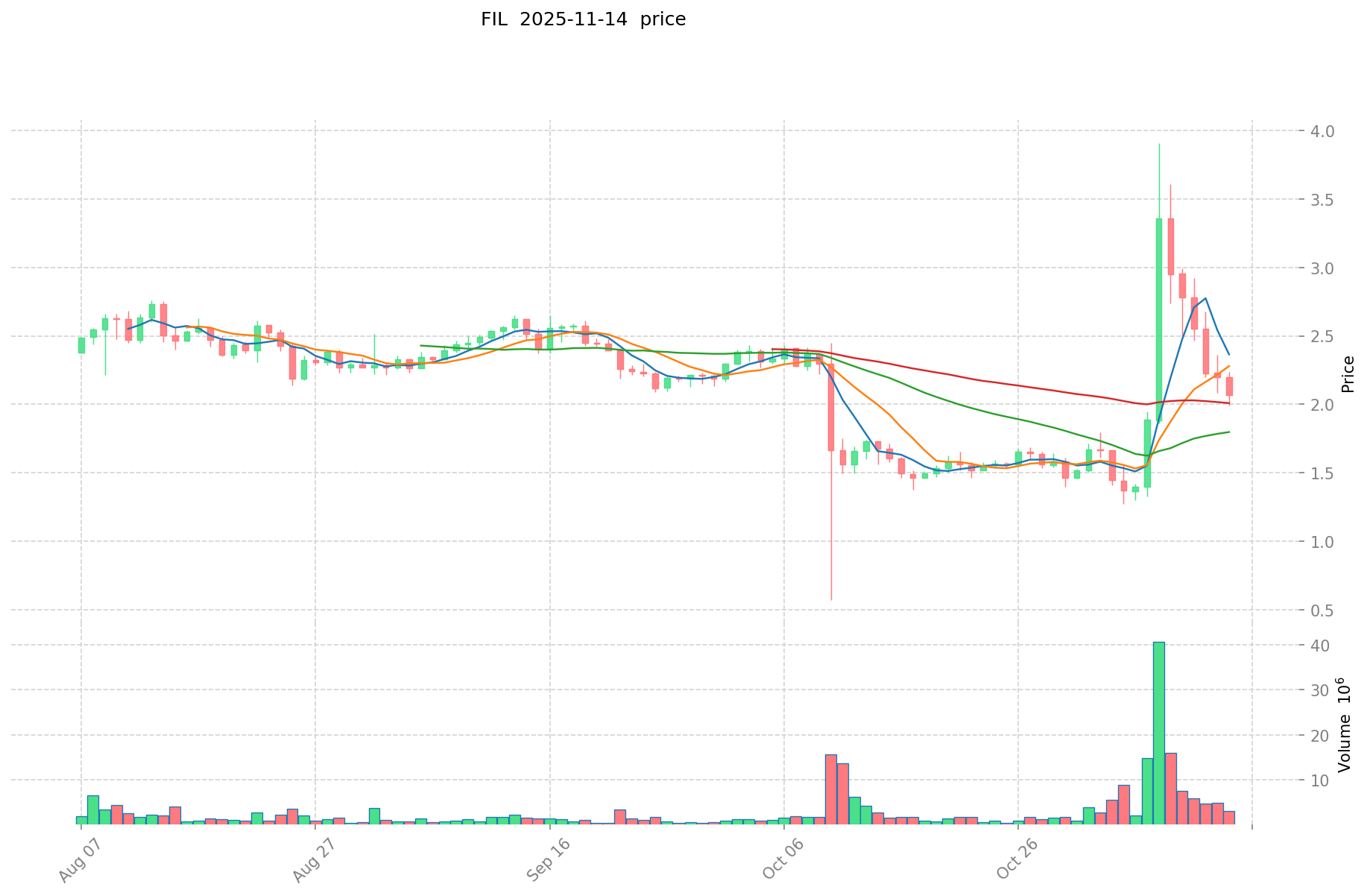APT vs FIL: Comparing Two Promising Cryptocurrencies in the Storage Sector
Introduction: APT vs FIL Investment Comparison
In the cryptocurrency market, Aptos (APT) vs Filecoin (FIL) comparison has always been a topic that investors can't ignore. The two not only have significant differences in market cap ranking, application scenarios, and price performance, but also represent different cryptocurrency asset positioning.
Aptos (APT): Since its launch in 2022, it has gained market recognition for its high-performance PoS Layer 1 blockchain.
Filecoin (FIL): Since its inception in 2020, it has been hailed as a decentralized storage network, and is one of the cryptocurrencies with the highest global trading volume and market capitalization.
This article will comprehensively analyze the investment value comparison between APT and FIL, focusing on historical price trends, supply mechanisms, institutional adoption, technological ecosystems, and future predictions, and attempt to answer the question that investors are most concerned about:
"Which is the better buy right now?"
I. Price History Comparison and Current Market Status
APT and FIL Historical Price Trends
- 2023: APT reached its all-time high of $19.92 on January 26, 2023.
- 2021: FIL hit its all-time high of $236.84 on April 1, 2021.
- Comparative analysis: APT has fallen from its peak of $19.92 to its current price of $2.996, while FIL has dropped from its high of $236.84 to $2.07.
Current Market Situation (2025-11-14)
- APT current price: $2.996
- FIL current price: $2.07
- 24-hour trading volume: APT $1,894,873.44 vs FIL $7,598,144.20
- Market Sentiment Index (Fear & Greed Index): 16 (Extreme Fear)
Click to view real-time prices:
- Check APT current price Market Price
- Check FIL current price Market Price


II. Core Factors Influencing APT vs FIL Investment Value
Supply Mechanism Comparison (Tokenomics)
- APT: Aptos uses an inflationary model with initial annual inflation of 7%, gradually decreasing to 3.25% as network participation increases. Total supply started at 1 billion tokens.
- FIL: Filecoin implements a deflationary mechanism with a maximum cap of 2 billion tokens. New tokens are minted as mining rewards, while token burning occurs through network usage fees.
- 📌 Historical pattern: Deflationary models like FIL's tend to support price appreciation during periods of increased network activity, while APT's declining inflation rate aims to balance network security with controlled supply growth.
Institutional Adoption and Market Applications
- Institutional holdings: Filecoin has secured partnerships with notable enterprises like Chainlink and Meme.com, while Aptos has backing from major venture capital firms including a16z and FTX Ventures.
- Enterprise adoption: Filecoin offers decentralized storage solutions being implemented across various industries, while Aptos focuses on financial applications with its high-performance transaction processing.
- National policies: Regulatory approaches vary by jurisdiction, with both projects facing varying levels of scrutiny in different markets.
Technical Development and Ecosystem Building
- APT technical upgrades: Aptos utilizes the Move programming language and parallel execution engine, delivering theoretical throughput of over 100,000 TPS with sub-second finality.
- FIL technical development: Filecoin continues enhancing its decentralized storage network with upgrades to its proof systems and integration with IPFS.
- Ecosystem comparison: Filecoin has established itself as a leading decentralized storage solution with significant real-world adoption, while Aptos is building its ecosystem around high-performance DeFi applications and user-friendly experiences.
Macroeconomic Factors and Market Cycles
- Performance during inflation: Filecoin's capped supply model potentially provides better inflation hedging characteristics compared to Aptos' initially higher inflation rate.
- Macroeconomic monetary policy: Both tokens exhibit sensitivity to broader crypto market conditions, which are increasingly correlated with traditional risk assets.
- Geopolitical factors: Filecoin's decentralized storage utility may provide resilience during geopolitical uncertainty, while Aptos' focus on transaction efficiency addresses cross-border payment needs.
III. 2025-2030 Price Prediction: APT vs FIL
Short-term Prediction (2025)
- APT: Conservative $2.19 - $3.00 | Optimistic $3.00 - $4.11
- FIL: Conservative $1.26 - $2.06 | Optimistic $2.06 - $2.75
Mid-term Prediction (2027)
- APT may enter a growth phase, with estimated price range $2.40 - $3.97
- FIL may enter a bullish market, with estimated price range $2.02 - $3.57
- Key drivers: Institutional capital inflow, ETF, ecosystem development
Long-term Prediction (2030)
- APT: Base scenario $3.62 - $4.96 | Optimistic scenario $4.96 - $6.49
- FIL: Base scenario $3.15 - $3.71 | Optimistic scenario $3.71 - $5.53
Disclaimer
APT:
| 年份 | 预测最高价 | 预测平均价格 | 预测最低价 | 涨跌幅 |
|---|---|---|---|---|
| 2025 | 4.10863 | 2.999 | 2.18927 | 0 |
| 2026 | 3.94473465 | 3.553815 | 2.7008994 | 18 |
| 2027 | 3.9742313145 | 3.749274825 | 2.399535888 | 25 |
| 2028 | 4.1320757846325 | 3.86175306975 | 2.548757026035 | 28 |
| 2029 | 5.91543335224305 | 3.99691442719125 | 3.717130417287862 | 33 |
| 2030 | 6.492587795529466 | 4.95617388971715 | 3.618006939493519 | 65 |
FIL:
| 年份 | 预测最高价 | 预测平均价格 | 预测最低价 | 涨跌幅 |
|---|---|---|---|---|
| 2025 | 2.74512 | 2.064 | 1.25904 | 0 |
| 2026 | 3.125928 | 2.40456 | 2.0679216 | 16 |
| 2027 | 3.56716476 | 2.765244 | 2.01862812 | 33 |
| 2028 | 3.641135037 | 3.16620438 | 2.7862598544 | 52 |
| 2029 | 4.01633025603 | 3.4036697085 | 2.11027521927 | 64 |
| 2030 | 5.52789997357485 | 3.709999982265 | 3.15349998492525 | 79 |
IV. Investment Strategy Comparison: APT vs FIL
Long-term vs Short-term Investment Strategies
- APT: Suitable for investors focused on high-performance blockchain ecosystems and DeFi potential
- FIL: Suitable for investors interested in decentralized storage solutions and Web3 infrastructure
Risk Management and Asset Allocation
- Conservative investors: APT: 30% vs FIL: 70%
- Aggressive investors: APT: 60% vs FIL: 40%
- Hedging tools: Stablecoin allocation, options, cross-currency portfolios
V. Potential Risk Comparison
Market Risks
- APT: Higher volatility due to newer market presence and evolving ecosystem
- FIL: Susceptibility to fluctuations in storage demand and competition from centralized alternatives
Technical Risks
- APT: Scalability challenges, network stability during high transaction periods
- FIL: Mining power concentration, potential security vulnerabilities in storage protocols
Regulatory Risks
- Global regulatory policies may impact both differently, with FIL potentially facing more scrutiny due to its data storage focus
VI. Conclusion: Which Is the Better Buy?
📌 Investment Value Summary:
- APT advantages: High-performance Layer 1 blockchain, potential for rapid ecosystem growth
- FIL advantages: Established decentralized storage network, real-world adoption in various industries
✅ Investment Advice:
- New investors: Consider a balanced approach with a slight bias towards FIL due to its more established market presence
- Experienced investors: Explore strategic allocation between APT and FIL based on risk tolerance and market analysis
- Institutional investors: Evaluate both for portfolio diversification, with FIL offering exposure to decentralized storage and APT to next-generation blockchain technology
⚠️ Risk Warning: Cryptocurrency markets are highly volatile, and this article does not constitute investment advice. None
VII. FAQ
Q1: What are the main differences between APT and FIL? A: APT is a high-performance Layer 1 blockchain focused on DeFi applications, while FIL is a decentralized storage network. APT uses an inflationary model with decreasing inflation rate, while FIL has a deflationary mechanism with a capped supply. APT is newer to the market, launched in 2022, while FIL has been around since 2020.
Q2: Which token has performed better historically? A: FIL reached a higher all-time high of $236.84 in April 2021, compared to APT's all-time high of $19.92 in January 2023. However, both have seen significant price decreases since their peaks. As of 2025-11-14, APT is trading at $2.996 while FIL is at $2.07.
Q3: What are the key factors influencing the investment value of APT and FIL? A: Key factors include supply mechanisms, institutional adoption, technical development, ecosystem building, macroeconomic factors, and market cycles. FIL's deflationary model and established presence in decentralized storage give it certain advantages, while APT's high-performance blockchain and potential for ecosystem growth are its strong points.
Q4: What are the price predictions for APT and FIL by 2030? A: For APT, the base scenario predicts a range of $3.62 - $4.96, with an optimistic scenario of $4.96 - $6.49. For FIL, the base scenario predicts $3.15 - $3.71, with an optimistic scenario of $3.71 - $5.53. However, these are estimates and actual prices may vary significantly.
Q5: How should investors approach APT and FIL in terms of asset allocation? A: Conservative investors might consider allocating 30% to APT and 70% to FIL, while aggressive investors might opt for 60% APT and 40% FIL. The exact allocation should depend on individual risk tolerance and market analysis.
Q6: What are the main risks associated with investing in APT and FIL? A: Both face market risks such as price volatility. APT may face technical risks related to scalability and network stability, while FIL could be affected by mining power concentration and potential security vulnerabilities. Regulatory risks also exist, with FIL potentially facing more scrutiny due to its focus on data storage.
Q7: Which token is considered the better buy? A: The better buy depends on individual investment goals and risk tolerance. FIL may be more suitable for those interested in established projects with real-world adoption, while APT could appeal to investors looking for high-performance blockchain potential. New investors might lean slightly towards FIL, while experienced investors could consider a strategic allocation between both.
Share
Content